
Break out the champagne, because the Mazda MX-5 Miata is 25 years old. Later this week at the New York Auto Show, Mazda will throw a birthday party for what is not only one of the most significant Japanese cars ever built, but one of the most important cars of all time.
It almost didn’t happen. During the 10 years from conception to production, a myriad of butterfly effect-like forces could have easily sank the Miata project or altered it beyond all recognition. And yet, here we are today, welcoming what just might be the perfect sports car past the 25-year threshold into classic-dom.
Like most legends, myths about its creation are plentiful. So in honor of this momentous occasion we at JNC are going to do what we do best: dig deep and bring you the origin stories.
To accompany this tale, Mazda gave us the opportunity to photograph the very first Miatas ever shown to the public. At the 1989 Chicago Auto Show, Mazda shook the motoring establishment by presenting four colorful little roadsters to the world. Initially the Miata was offered in only three colors, and since America had been chosen to introduce the car to the world, red, white, and blue comprised the perfect array (Silver Stone Metallic was introduced later that first year).
Each one of them has led interesting lives in the subsequent quarter century. The Classic Red car, serial number 00015, is the lowest mileage car of the bunch with just 4,005 ticks. It still sports its original 14-inch Yokohama Advan A-460 tires, now unobtainium, as does the blue one. Peeking underneath reveals painted control arms and sway bars, indicating that at some point this car was displayed on a stand to highlight the soul of the Miata, its agile suspension.
The Crystal White car, serial number 00017, was the very first Miata race car. Mazda likes to boast about how they are the most represented marque on American race tracks on any given weekend, a stat due in large part to the Miata. and here’s the one that started it all. Its driver, Dan Edmunds (now of Edmunds.com, no relation to the site’s founder) was meticulous about his cars, so even though this car reads 6,483 battle hardened miles the engine bay is cleaner than that of many civilian cars.
Resplendent in iconic Mariner Blue, serial number 00014 is the earliest and most original. Its odometer shows a comparatively high 8,303 miles, but everything is as it was the day it rolled off the line in Hiroshima. It’s likely the most museum-worthy Miata in the country, if not the world.
Overshadowed at the time was the yellow Club Racer, displayed alongside its stock brethren at Chicago to showcase the Miata’s tuning potential right from the start (We will cover it in depth in a later article). Just for fun, Mazda also brought out the 1996 M Coupé, a car I personally remember lusting over in the pages of Road & Track as a college student. That I actually got to drive it (however briefly and not on public roads) was a personal can’t-believe-I’m-doing-this moment.
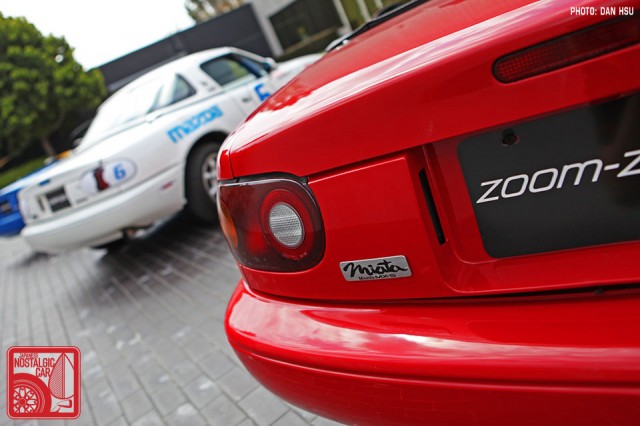
To get the skinny on the Miata’s genesis, we sat down with Bob Hall, a former product planner that Automobile magazine has christened the Father of the Miata, though as we will see later he doesn’t necessarily agree with that title. In 1978 Hall was a journalist for Automotive News and Autoweek and one of his assignments was interviewing former Mazda head of R&D Keniichi Yamamoto, the man who developed the rotary engine into a viable motor.
The two of them had developed a good relationship, and after one interview Yamamoto casually asked Hall what kind of car he’d like to see Mazda build. Hall, who had grown up around the British roadsters his father owned, said he’d like to see a small, rear-wheel-drive roadster in the vein of his Dad’s Austin Healey but without the nightmarish reliability.

Hall’s story has been well documented in a number of sources, but rarely do they mention what really sets him apart: Bob Hall might be the first gaijin ever to do the “JDM” thing, and he did it decades before anyone took notice.
Hall was an exchange student in Nagoya in 1971, smack dab in the heyday of JNC heaven. He owned 1968 Datsun 510 back in the States, and soon noticed the differences between his car and the Japanese SSS Coupes. Next thing you know, he was dragin parts like a JDM rear garnish and 6-gauge instrument panel on trans-Pacific flights back home. Before long, he had the coolest 510 on Mulholland Drive, and while US-based street racers rocked BRE bits Hall’s car sat 10mm lower thanks to Nissan Racing suspension bits.
Hall’s curious ownership history also includes a 1977 Isuzu Gemini, purchased as an Opel Buick but lowered and decked out with JDM bumpers, as well as a 323 Familia-based 5-door Mercury Tracer with a Ford Laser TX3-swapped nose.

Two years after the exchange with Yamamoto, Hall had switched careers for his dream job, a position at Mazda North America. Only, instead of the sports car he had envisioned, Hall had been assigned work on the B-series. By chance, Yamamoto saw him slaving away on the pickup one day and asked if he was still interested in developing the roadster. The answer, of course, was yes.
The creation of something as complex as an automobile requires a perfect storm of variables, and the path to classic status is riddled with pitfalls. Here is a list of just some of the other factors that could have made history very different for the Miata.
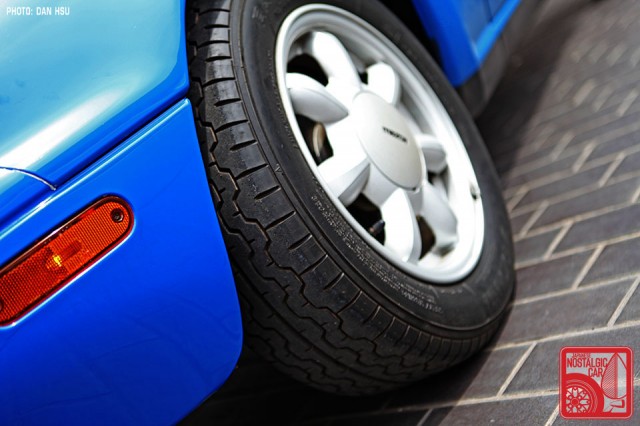
For one, the worldwide market for roadsters was drying up. Sure, it was largely because British and Italian craftsmanship was as airtight as a soufflé, but product planners anywhere other than Mazda would have taken that as a sign to run screaming for the hills away from two-seater convertibles.
Furthermore, rear-wheel-drive was considered archaic at the time. Front-drive layouts were the wave of the future, and the Familia (aka 323, GLC) on which the Miata was, at a time, to be based was shifting from a RWD to FWD layout.
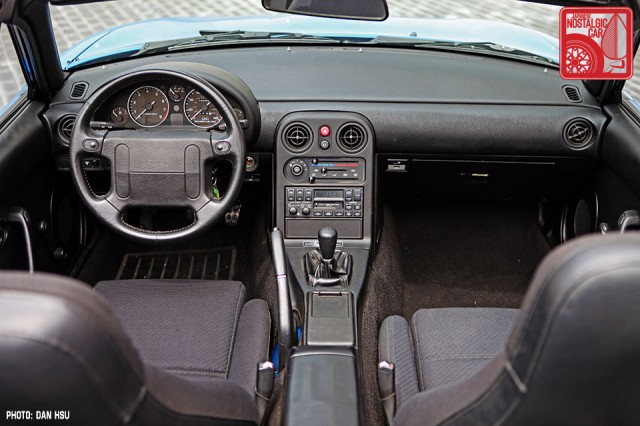
Other mishaps completely unrelated to the car itself abounded. In the 80s, Mazda went on a ridiculous money-wasting tangent to multiply its sales channels in an effort to chase Toyota and Nissan. Eunos, Autozam and Efini dealerships, and even a proposed Amati luxury line in the vein of Acura or Lexus hemorrhaged yen for the small automaker. That, combined with demands from its tie-up with Ford, hiked the number of models required from each platform from four to nine, threatening to spread the engineers and designers too thin.
Even after it reached production, the project’s success wasn’t guaranteed. An oversight of British registration rules when planning the 1994 bump to 1.8 liters bludgeoned UK sales for a bit. US dealers overestimated the sales potential of a non-power steering base model by half. Then there was the Asian financial crisis and the unforeseen popularity of SUVs, both of which had massive ramifications for any automaker trying to sell a sports car in the 1990s.
But despite it all, the Miata prevailed. Mazda is unique in the automotive world in its willingness to take risks. It’s as if old Shoeless Joe Jackson was whispering to Mazda,, “If you build it, they will come.”
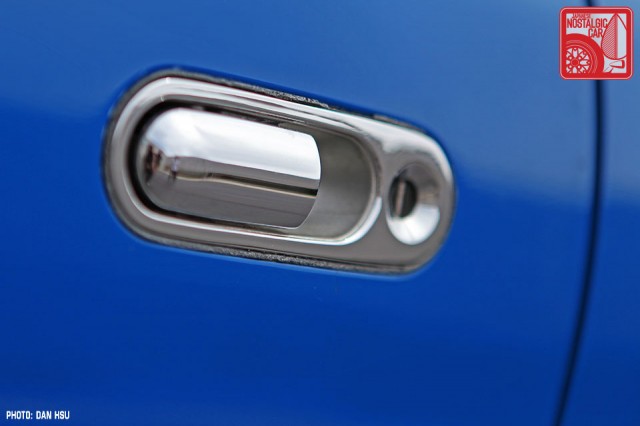
By late 1982 the Miata, then still called the Light Weight Sports) project was officially underway (ie, money had been allocated). However, LWS was still part of an internal program called Offline 55 (55 is read as “Go Go!” in Japanese and would become the racing number of the Le Mans winning 787B years later) whose projects weren’t slated for production. Instead, they were purely for inspiring designers and engineers to come flex their mental muscle.
Hall himself was told that he could work on his roadster, but not on official company time. Before long, however, management noticed that Offline 55 ideas from the US and Japan offices both included two-seat convertibles. The Japan studio designs consisted of a round-edged FF car and a futuristic MR roadster not unlike an AW11 MR2. The US studio’s hewed most closely to Hall’s original FR concept, though with a less angular body than he originally proposed.
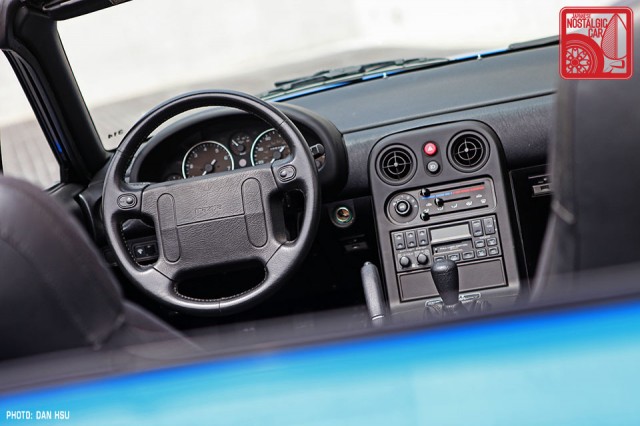
An internal competition was held and all three designs were submitted for review. According to Hall, when the Tokyo studio head saw the FR version he pointed at it and shouted, “Make that one!”
As the saying goes, success has many fathers. In the case of the Miata, it’s true. Hall had come up with the concept and continued to work on it throughout. Mark Jordan (son of legendary GM head of design Chuck Jordan) and Masao Yagi did the early design work and solidified the basic theme. Tom Matano (designer of the FD RX-7) and Shigenori Fukuda sculpted the first clay model. WuHuang Chin did the detailing, including integration of the taillight elements (Fun fact: the round brake light was meant to evoke the hidden afterburners of the 1989+ FC RX-7). Norm Garrett did the initial suspension layout using a 323 GTX diff and independent rear, while Takao Kijima worked on the suspension tuning. All of these men have been credited at one time or another for “creating” the Miata, but the truth is they all did.

Ultimately, however, Hall says that the Miata belongs to project lead Toshihiko Hirai. Affectionately known as “Pops” Hirai, he had worked on a number of Mazda cars including the Familia and Capella, but was most notably the design lead of the Autozam AZ-1. According to Hall, Hirai was the one responsible for advocating for the Miata internally and the one who kept the Light Weight Sport project pure in the eight years it was under development.
From the body to the exhaust note to the fact that the top had to be simple enough to be operated one-handed, Hirai made sure the vision of a fun-to-drive roadster remained undiluted. He fought to keep the “wants” list short in the face of committees, engineers and marketers.

The MX-5 was originally going to be on a four-year product cycle, but when it was realized that the first generation would have to at least double that, the fact that Hirai didn’t allow any “state of the moment” styling cues became invaluable. Instead, the team went with a timeless design, one that, incidentally, was not based on the Lotus Elan (more on that in an upcoming article).
And it was Hirai who came up with the Japanese phrase now synonymous with the Miata: jinba ittai, or “horse and rider as one,” taken from when ancient warriors steered their stallions with tiny inputs of their knees so they could use both hands to wield a bow and arrow. When asked what is the heart of a car, likely answers will be the engine or the body. In the case of Hirai’s Miata, it was always the suspension. From the very beginning, it was determined that the car need not be fast, but it had to be fun.
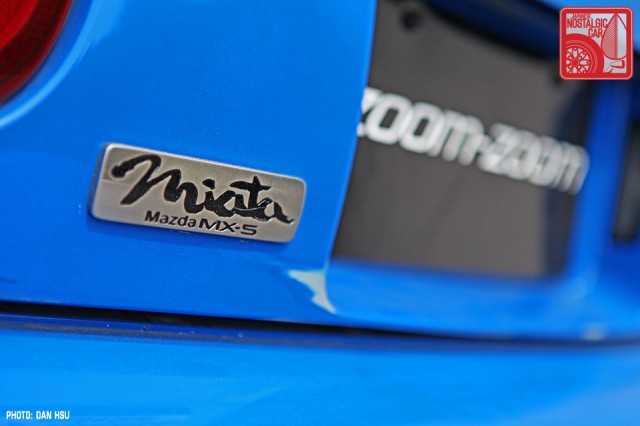
Maintaining that purity of concept was no easy task in the face of the Miata project’s myriad of pitfalls. Hirai himself was fond of saying that there were many times when a small breeze could have sidelined the entire program. But rather than succumb to product planners and bean counters, the Miata was built from passion to become one of the greatest success stories in automotive history. Says Hall, “Without Hirai, there’d be no car.”
The minute it was announced at Chicago orders started pouring in. Like the Datsun 240Z craze 20 years earlier, dealers were selling out faster than the trucks could deliver them. US and Japan sales alone more than doubled Mazda’s sales forecasts of 40,000 per year, and soon everyone from Audi to Porsche was developing a similar car. Even those who had worked on the project could barely believe the sales, which have since made the MX-5 the best selling sports car of all time.
Against all odds Mazda built it, and the people did come. Happy 25th birthday and welcome to the club, Miata.

























I will take the yellow one with the Panasports on it.
I’m a bit confused. Was the Miata released in April of 89? Or was it still just a concept vehicle shown at auto shows? Even if it was released earlier in the year, you won’t find a single Miata titled as an 89. The earliest Miata’s were sold as 90 model year, which would put the 25 year mark in 2015. Or am I missing something?
I believe Mazda sold the Miata in 1989 as a “1990” model. As far I remember Miata was first sold at around April-May of 1989. Correct me if I am wrong tho!
Yes it came out in spring of 1989. I bought my Mariner Blue in July of that year, and still have it, 96,000 miles later. Runs like a top! 🙂
ditto…I ordered my Mariner Blue in July of ’89 and took delivery in September. Still running strong!
Is that the Mariner Blue Miata with the ‘MY MX5′ plate owned by Danny and Jan that were founder members of BAMA? If so, ’89 MIATA’ is still going strong too and I’d love to get in touch. Are you going to the 25th-anniversary at Laguna Seca in September?
OMG what a fantastic read!!! Really highlights how deceptively simple both the Miata and its development story are. The people behind it really did an amazing job. The M Coupe definitely sits near the top on my list of most coveted concept cars. I still LOVE it, the idea of it, and the prospect, however slim, that one day there’ll be a production Miata coupe. Miata’s story and legacy are becoming stuff of legend. And the “Offline 55” bit, so awesome! Kinda similar to how the RX-8 was developed, too =P Too bad Bob Hall didn’t have a photo of his JDM-ized Familia/Tracer/TX3; I’d love to see it! One day, I will get myself an NA. Looking forward to the next installments of this story…
whatever the case i hope organisers will cap miata entries at car shows else we’ll have a miata show plus extras
This piece has reminded me what a great-looking car a stock Mariner Blue Miata is.
It’s a pity the US was lumbered with that bloody awful airbag steering wheel though. Europe and Japan got a lovely three-spoke Momo wheel.
Great article! After wanting one for quite some time, I picked up my 94 BRG 1.8 in June of last year, and it has been everything I’ve wanted and more. I have never loved a car more than it, so much so that I just recently picked up a second one, a 91 1.6, that is in pretty rough shape, to fix up a little and use as a winter car.
I have finally found THE car for me… 🙂
I love BRG NAs! That, Sunburst Yellow, Mariner Blue, and just plain white with hardtop are my favorite shades on the car.
Thank you JNC! Stories like this are exactly the type of article that keeps the motoring enthusiast fire burning.
now i can finally put the jnc decal on my hardtop
What Kira said.
Awesome article.
*sigh*. I miss my ’94 M Edition street/track car.
I attended the Chicago Auto Show that winter when these first came out and wanted one. I couldn’t afford a new one so in June of that year I bought a 1966 Datsun Roadster 1600 instead.
After 6 years of ownership I sold my Datsun and today I am interested in a toy car and now it looks like all I can afford is an older Miata as Datsun’s have gone up in price!
” Initially the Miata was offered in only three colors, and since America had been chosen to introduce the car to the world, red, white, and blue comprised the perfect array (Silver Stone Metallic was introduced later that first year).”
According to a Q&A on Jalopnik, the colors weren’t chosen because of Old Glory/USA connection, it was because of three countries racing colors: http://jalopnik.com/the-mazda-miatas-creator-is-happy-you-think-his-car-is-1564400029
France – Blue
Red – Japan
White – USA
Why British Racing Green wasn’t chosen is beyond me….
I totally agree with Dave’s comment (April 15 at 10:13 am.) regarding this article.
While reading this article I could feel the amount of passion that emanated from the deepest recesses of the souls of the gentlemen that are responsible for the existence of the MX5.
Such is the magnitude of that passion, which endured for 8 years, that made it possible to create the worlds best selling sports car of all time.
To a non MX5 owner, this article is just another well written piece of automotive journalism, but to an MX5 owner it is a testimony of pride in ownership of one of the worlds greatest sports car, the Mazda MX5 Miata!
And yes, I proudly own one, a white NA. 🙂
I own 1989 serial number 00064. Build date March 1989. Love it!!.
at 65 just getting into these and sorry I hadn’t earlier. My sister has had one for some years and I really hadn’t taken any notice let alone drive one.
A few months ago I purchased a 1991 vspec BRG roadster 1.6 and really liked it ,but sold it soon after.
It wasn’t until it was gone I realised my interest had increased.
A couple of weeks ago I purchased a 1996 brilliant black NA series S- Special Type 2 for $3000 NZ dollars ( ex Japan ) it’s totally original complete with torsion lsd,15 inch BBS wheels,1.8 135 HP engine,mono wheel,nardi knob ,….I’m enjoying tiding up wee bits and pieces and have decided ITS A KEEPER…I’d love to know how many of this model were built and how popular they are as its only the second one I’ve seen in NEWZEALAND….please post info if you have some…I’ve read most of the Internet info etc but the number built eludes me…mine has black strut brace,braces around diff, factory seat bar and green roadster badge ,black hazard light switch,black seats etc….,cheers DAVE THE KIWI.
I own serial number 0007832. Build date June 1989. I have had it for seven years. It is all original. Mariner Blue. A time warp car. Love it also!!! 65K miles on it. Like a new car. Have to restrain myself. Less than 1K miles per year. Talk to me!!!
I own vin 00026, mariner blue pre-production car. The car wich was supposed to be destroyed was exported from Mazda US to Germany then sold to a collectioner in the Netherlands then sold to me last week. My car has some unique features. It is believed to have been built in November 1988. It will be soon be exhibited at the Autoworld museum in Brussels as part of their permanent exhibition.